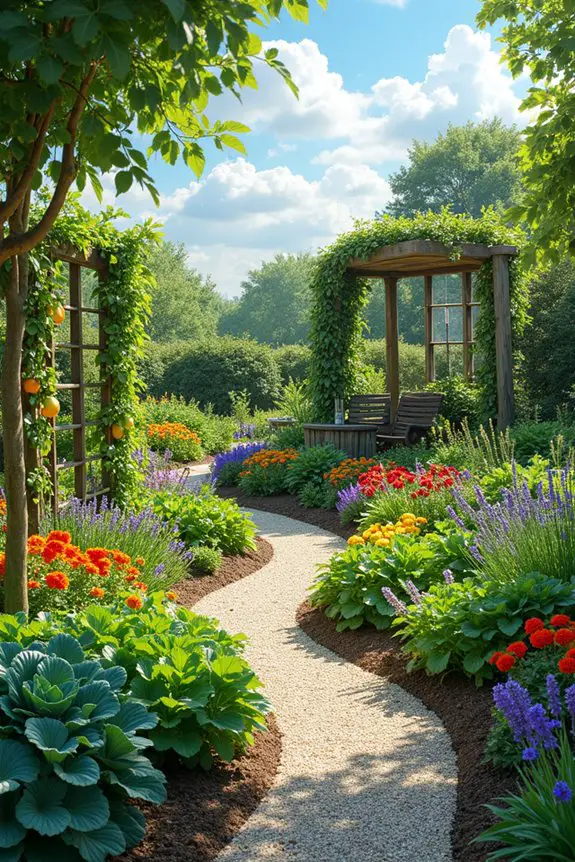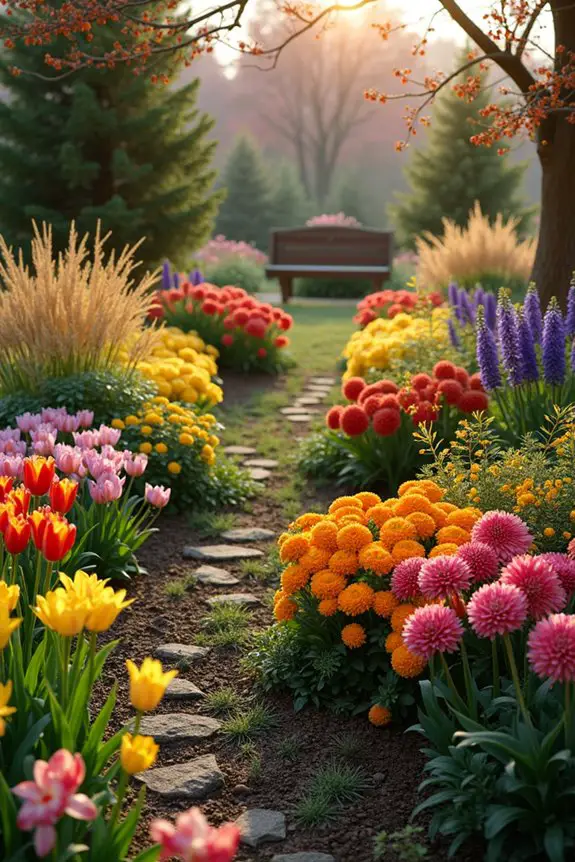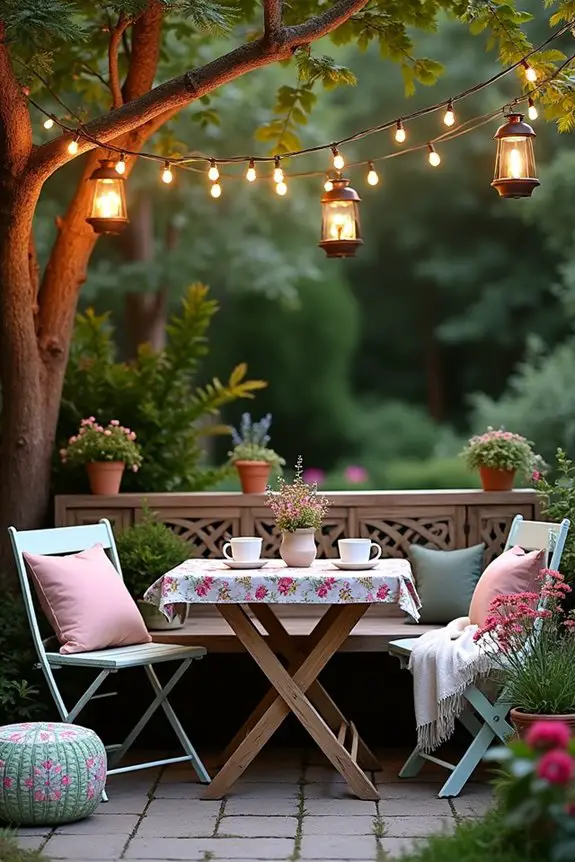Did you know that gardens can boost your mood and even lower stress levels? Creating a personal green space can feel a bit challenging, but it doesn’t have to be a heart-pounding race against time. Whether you fancy a serene Zen garden or a riot of colorful blooms, there’s something here for everyone. Let’s explore some garden design ideas that can sprinkle a little joy into your everyday life, and keep you coming back for more inspiration.
The Garden Layouts
When it comes to garden layouts, you’ve got so many exciting options to explore.
Imagine a serene Zen garden, a vibrant flower bed bursting with colors, or even a cozy cottage-style setting that feels like a mini vacation in your backyard.
Each layout has its own charm and benefits, and you might just find one that speaks to your gardening soul.
1. Zen Garden Layout
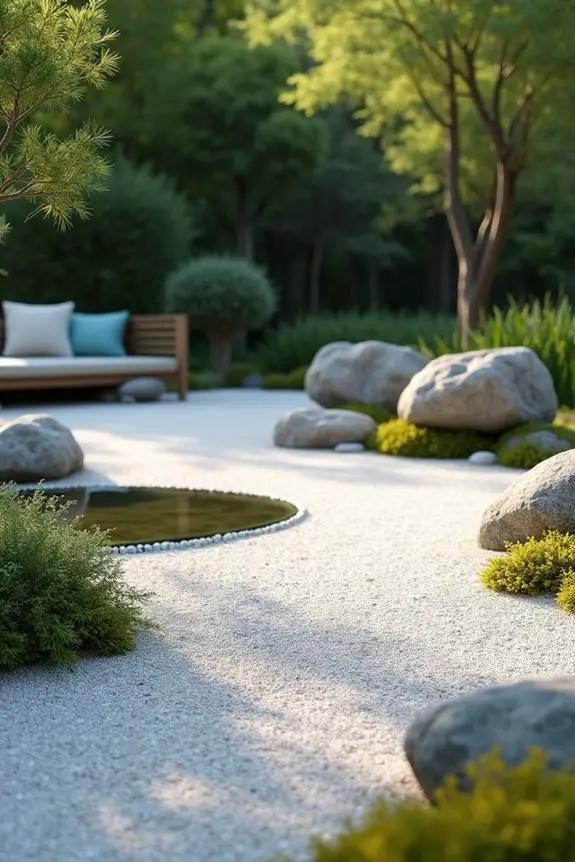
Creating a Zen garden layout can truly transform your outdoor space into a serene retreat. Why does this idea work? Well, it’s all about simplicity and tranquility. A Zen garden embraces minimalism, allowing for reflection and relaxation.
It’s like hitting the pause button on life, helping you unwind after a long day, or maybe just after one too many meetings.
When designing your Zen garden, think about a classic gravel bed—this is your canvas. Rake the gravel into soothing patterns—think waves or ripples. Honestly, it’s surprisingly therapeutic, like creating art but with less pressure and more gravel. The use of a hori hori garden knife can be incredibly beneficial for digging and planting in your Zen garden.
You can incorporate stones of varying sizes, placed strategically to represent islands or mountain peaks. Trust me, tossing a big rock into the mix? It feels satisfying, almost like you’re a Zen garden Picasso in your own right.
Next up, consider adding a few plants, like moss or low-growing shrubs. They offer a pop of color without overwhelming the space.
Keep it simple and low maintenance, because who wants to spend their Zen time weeding? And hey, if you have the space, a small water feature can create calming sounds that lull you into a state of bliss. Plus, when you’re tending to your Zen garden, you might find that using anvil pruning shears can help keep your plants shaped perfectly for that minimalist look.
Just make sure it’s not so big that you start convincing yourself it’s a mini-lake—that’s too much pressure for a Zen garden.
Finally, set up a comfortable spot nearby, maybe a bench or even just a couple of cushions. You want to create a space where you can sit, breathe, and soak in the peace.
2. Colorful Flower Bed Design
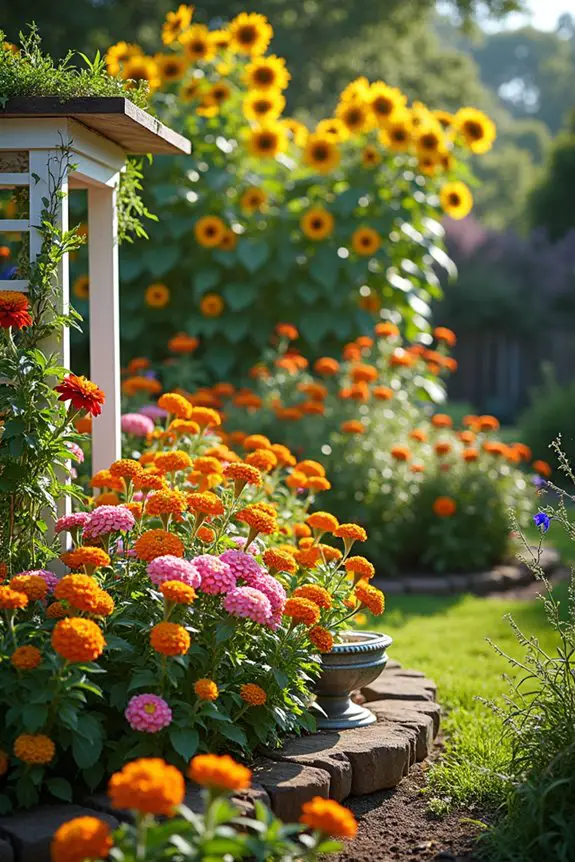
Imagine stepping into your yard and being greeted by a dazzling display of colors, like walking into a joyful painting. That’s the magic of a well-designed flower bed. This idea works because it’s not just about looks—bright flowers can boost your mood and attract butterflies, bees, and those lovely hummingbirds, adding life to your garden.
Plus, creating layers and patterns can transform an ordinary patch of dirt into a vibrant canvas that reflects your personality. Consider using a wood raised bed kit to define your flower bed area, helping to create a structured yet beautiful space.
Start with a clear vision. Think about your favorite flowers and colors. Do you prefer warm shades like reds and oranges or cool tones like blues and purples? It’s important to choose flowers that bloom at different times of the year, so your garden remains lively throughout the seasons.
A mix of perennials and annuals can help you achieve that—you get the longevity of perennials and the chance to experiment with annuals each year.
Now, let’s get into some specifics. When you plant your flowers, layer them—taller plants at the back and shorter ones in front. Imagine it like a concert, where the tallest performers are in the back, ensuring everyone gets a good view.
A classic combo could be sunflowers in the back, zinnias in the middle, and marigolds in the front for a cheerful vibe. Don’t be afraid to play around with textures too; the spiky leaves of ornamental grasses mixed with soft petaled flowers create a stunning contrast.
To add some flair, consider incorporating garden ornaments or a whimsical trellis for climbing flowers. It’s like accessorizing your outfit—you want to leave an impression without going overboard, right?
So, a cute little birdbath or a decorative stone can be just what you need to tie everything together.
Finally, don’t forget to regularly tend to your flower bed. Weeding, deadheading spent blooms, and giving a little water here and there will help maintain that vibrant tapestry.
making use of proper seed storage box compartments can really help in keeping your gardening supplies organized and accessible, ensuring that you have everything you need at your fingertips.
Personally, I’ve learned that if I let the weeds take over, it’s akin to letting my sock drawer unravel—it just spirals out of control.
And when in doubt? Grab a gardening buddy, because planting is way more fun with a pal by your side, sharing tips, laughs, and maybe a few too many stories about why that one flower just refuses to bloom.
3. Vertical Gardening Techniques
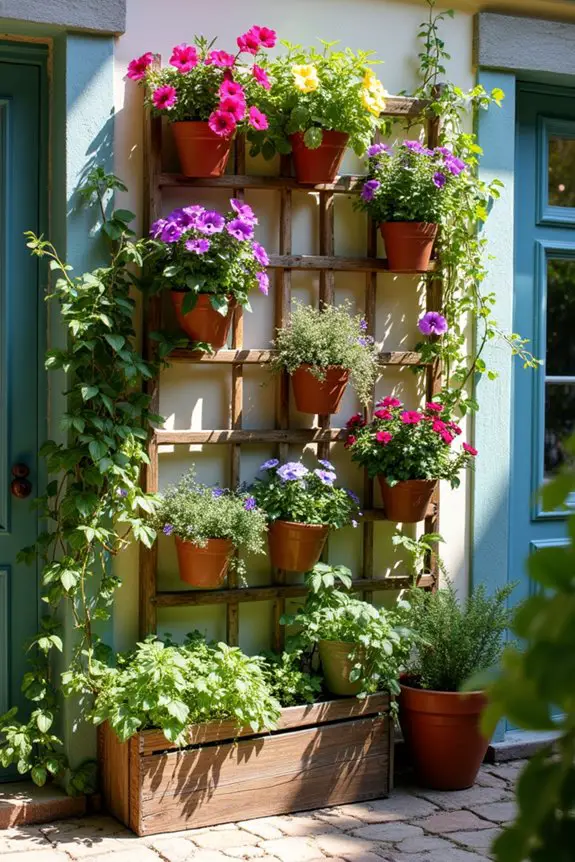
Vertical gardening techniques are a fantastic way to utilize space while adding a touch of elegance and whimsy to your outdoor oasis. This concept works beautifully because it not only saves ground space, which is a game-changer for smaller yards or patios, but it also allows plants to be showcased at various heights, creating an inviting and layered aesthetic that can wow your guests.
Who wouldn’t want a garden that draws the eye up as well as down, giving a whole new dimension to your plant life?
To kick things off, think about your available vertical space. If you have a fence, wall, or even a sturdy trellis, you’re already halfway there.
Lightweight containers or wall-mounted planters are a simple and stylish way to start your vertical garden journey. Just imagine, a cascade of colorful petunias or vibrant herbs hanging down from above. It’s like nature’s art installation, and you’re the artist!
When selecting plants, aim for climbers and cascading beauties. Vining plants like sweet peas or climbing roses can reach new heights, literally, while trailing varieties like ivy or lobelia can drape down gracefully, creating a lush waterfall effect.
I once had a friend who went all in with vining cherry tomatoes—every time we reached up for a fresh snack, it was like a delicious little game of nature’s own hide-and-seek. Who knew gardening could be so tasty?
Now, let’s talk about structure. You can invest in ready-made vertical gardens, or get crafty and design your own with wooden pallets or repurposed shoe organizers (yes, those dusty things in the back of your closet can finally have a purpose). Plus, consider using a watering wand with shutoff to make the maintenance process easier and more efficient.
Just remember to guarantee proper drainage; the last thing you want is your plants to drown. Nobody likes a soggy salad, right?
Lastly, don’t skimp on maintenance. Regular watering and pruning will keep your vertical garden healthy and happy, and a little fertilizer here and there can do wonders.
Trust me, I’ve learned the hard way that neglecting a vertical garden can look more like “messy spaghetti” than a beautiful display. It’s all about keeping that height, color, and surprise factor intact.
4. Sustainable Landscape Design Principles
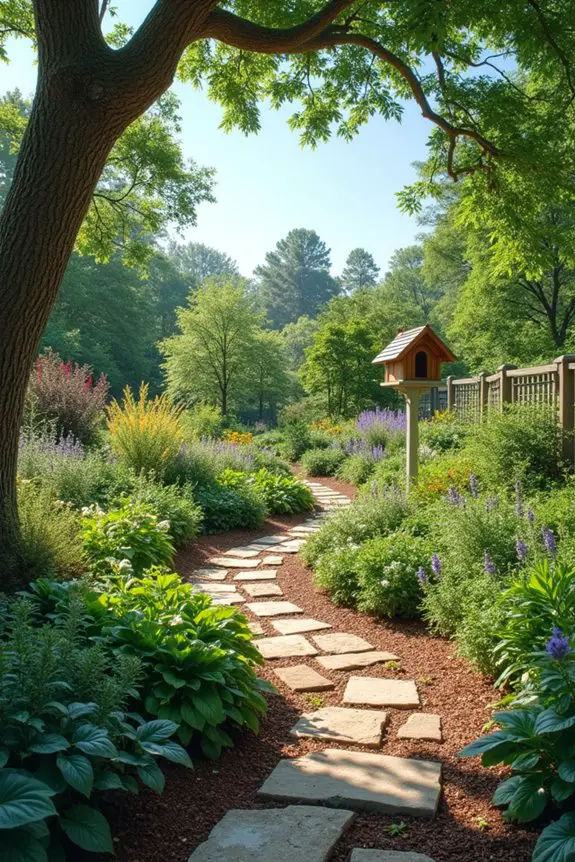
When you think about sustainable landscape design, you’d be surprised at how these principles can transform your space into a harmony of beauty and functionality. Envision walking into your backyard and instantly feeling a sense of peace, knowing you’re contributing to the environment while enjoying a lush, flourishing garden. It’s like hitting two birds with one eco-friendly stone, isn’t it?
First off, let’s talk about the layout. Visualize this: a thoughtfully planned design that works with the natural shapes and features of your yard. Instead of fighting against the landscape, you’re flowing with it—creating gentle curves instead of sharp angles.
This not only looks appealing but also allows for better drainage and easier maintenance. I once tried to impose a strict rectangular garden in my backyard, and let’s just say it ended up resembling a tetris game gone wrong. Flow is your friend—trust me.
Next, consider plant selection. Choose native plants that thrive in your local environment. Native species often require less water and are less susceptible to pests, so you save money and time.
It’s like inviting the best neighbors over for a party; they bring their own snacks while you sip lemonade in the sun. I tried growing exotic plants once thinking they’d impress my friends, but I ended up becoming a full-time plant paramedic instead. Lesson learned: go local.
Now, think about adding some organic material. This could be anything from compost to mulch. It’s like giving your plants a cozy blanket. Adding richness to your soil improves water retention and encourages beneficial microbes, making your garden thrive like you’ve given it a magic potion.
I remember tossing in some leftover vegetable scraps from dinner—next thing I knew, I was practically operating a mini-ecosystem.
Don’t forget to plan for wildlife as well. Creating habitats for birds, bees, and butterflies isn’t just good for nature; it also adds life to your garden.
Consider a birdbath or a small rock pile for insects—nature’s busy little friends will add a dynamic element to your space. Who knew making room for critters could turn my garden into the local hangout spot?
Lastly, maintenance doesn’t have to be a chore. Set up a system that works for you—put things like pruning and mulching on your calendar, so it feels less like an overwhelming task and more like a fun gardening date.
I put it off for weeks once, and I think I accidentally established a small jungle in my backyard. Oops.
Embrace these sustainable principles in your garden, and you’ll not only create an inviting space for yourself but also for the planet. And who doesn’t want their garden to be the cool eco-friendly spot on the block?
5. Cottage-Style Garden Design
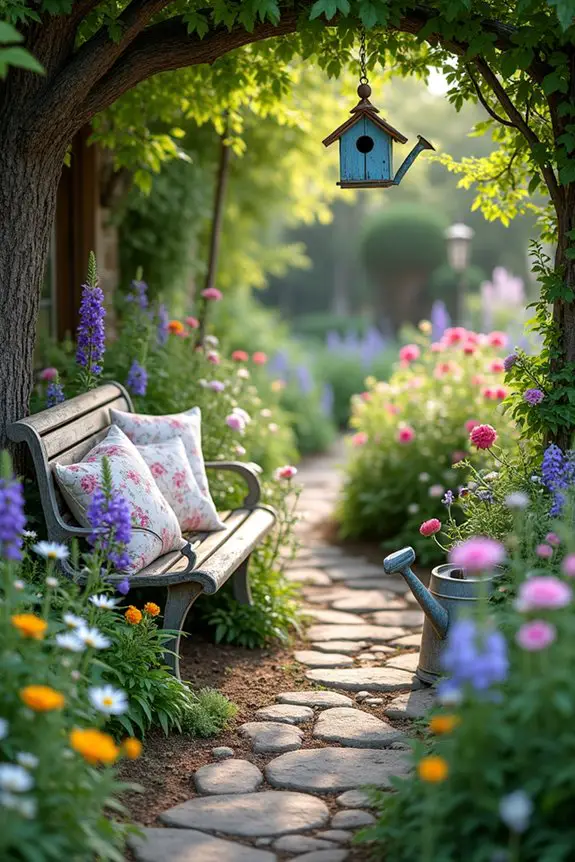
There’s something undeniably charming about a cottage-style garden layout. Envision this: meandering pathways, a delightful mix of colorful blooms, and secret nooks nestled between lush greenery. This design doesn’t just look beautiful; it creates a cozy, inviting vibe—like wrapping yourself in a warm blanket on a chilly day.
Start with a winding path. Instead of a straight line, let your walkway twist and turn, guiding visitors through your garden. It’s like inviting someone on a mini adventure. I once laid out a path so straight it could double as a runway for planes, and believe me, it lacked that cozy charm. Now, I incorporate curves that encourage slow walks, making it a delightful journey, not just a destination.
Next, think about variety. Cottage gardens thrive on diversity, so mix your flowers, shrubs, and herbs. Use something tall like foxgloves alongside low-growing plants like chamomile. It’s like a party where everyone gets a chance to shine, and trust me, even the mix of your flowers can make or break the whole vibe.
I tried planting all my sunflowers in one section once, and let’s just say it looked like a giant sunflower convention gone rogue. Balance is key.
Don’t forget the elements of surprise. Hide little treasures like a birdhouse or a whimsical sculpture among your flora. This adds character and invites guests to explore—like a treasure hunt in your backyard. I once tucked a gnome in the far corner of my garden, and now it sparks joy for everyone who discovers it.
Just beware of hiding spots; I lost my gardening gloves to a particularly difficult-to-reach one for way too long.
To top it off, incorporate seating areas. A little bench or a rustic chair invites you (or your friends) to sit, sip tea, and enjoy the view. These spaces can be little gems, perfect for morning coffee or an afternoon of daydreaming. I’ve a plywood seat that’s definitely seen better days, but it holds a special place in my heart and even more in my garden.
Embrace the cottage spirit by allowing your garden to look a bit wild and overgrown. It’s part of the charm. Don’t be afraid to let plants mingle like old friends, creating that organic feel.
I used to be a strict pruner, but now I let my garden be a little unruly—a true reflection of the joys of nature.
6. Herb Garden Design Ideas
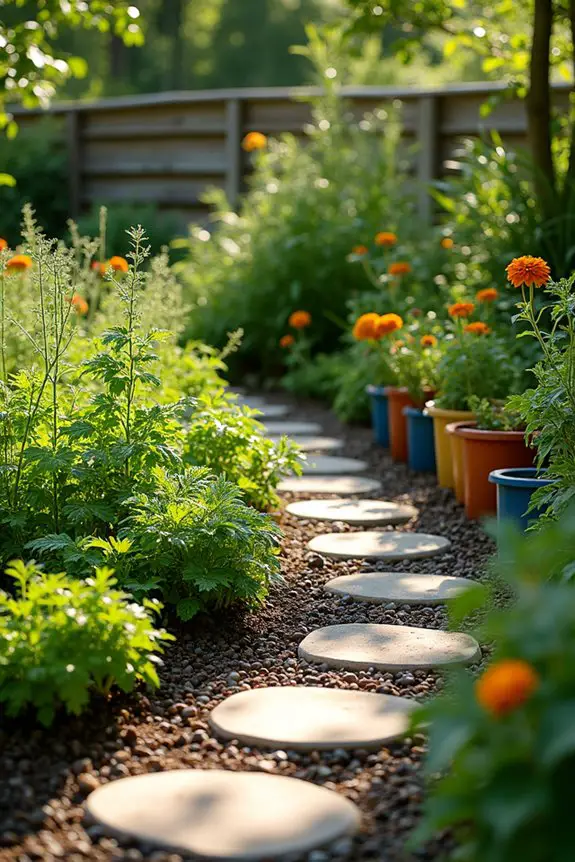
When it comes to designing an herb garden, the layout is essential. Not only should it be functional for your cooking needs, but it should also evoke a sense of tranquility, making it a lovely spot to unwind. Think of it as a little slice of nature where simplicity meets beauty—just waiting for you to harvest something fresh and flavorful.
Start with a raised bed or container garden; both options are great for herbs. Raised beds not only make it easier on your back but can also enhance drainage and soil quality. I once planted my herbs directly in the ground like they were living in a penthouse, but they were so hard to reach for a quick snip that I found myself wishing for a gardening yoga class. Now, my herbs are neatly contained and easily accessible, perfect for when I’m whipping up a delicious dinner or want to garnish my fancy glass of water.
Next, consider grouping your herbs by height and growing needs. For instance, place tall plants like basil and dill toward the back (or center, if it’s a circular bed), and shorter ones, like thyme or oregano, in the front. It’s like a well-staged show where everyone can see their moment in the spotlight. I once thought it’d be cute to mix all the herbs randomly, but I ended up with a jungle of confusion—imagine hunting for rosemary in a sea of mint, all the while the neighbors wondered if I was opening a botanical maze.
Color coordination? Yes, please! Herbs can be just as eye-catching as flowers when arranged thoughtfully. You might want to mix herbs with vibrant colored pots or plant them in soil that contrasts beautifully with their green foliage. Just take a look at my old herb garden, where the wild parsley could have been mistaken for jungle foliage. Once I switched to colorful planters that popped, it felt like a party of flavor right on my patio.
Don’t forget to incorporate pathways or stepping stones. These not only help in traversing through your herb garden but also give it an organized look. I once faced the consequences of a wild garden, teetering on my tiptoes trying to dodge sudden plant growth. Now, with a clear path laid out, I can parade through my garden proudly. Plus, it keeps muddy footprints away when you dash out with a handful of herbs to impress your dinner guests.
Lastly, embrace companionship in your herb garden. Plant things like marigolds or nasturtiums alongside your herbs; they not only look gorgeous but can deter pesky pests, too. I planted my marigolds thinking they were merely pretty faces. Turns out, they’re like the bouncers of the garden, keeping bad bugs away while my herbs mingle—who knew?
An herb garden layout should never be just about functionality; it’s about creating a serene escape to nurture both your plants and your soul. So grab your trowel and get planting—your future self will thank you when you’re reaching for fresh herbs instead of bland leftovers.
7. Garden Pathway Design Ideas
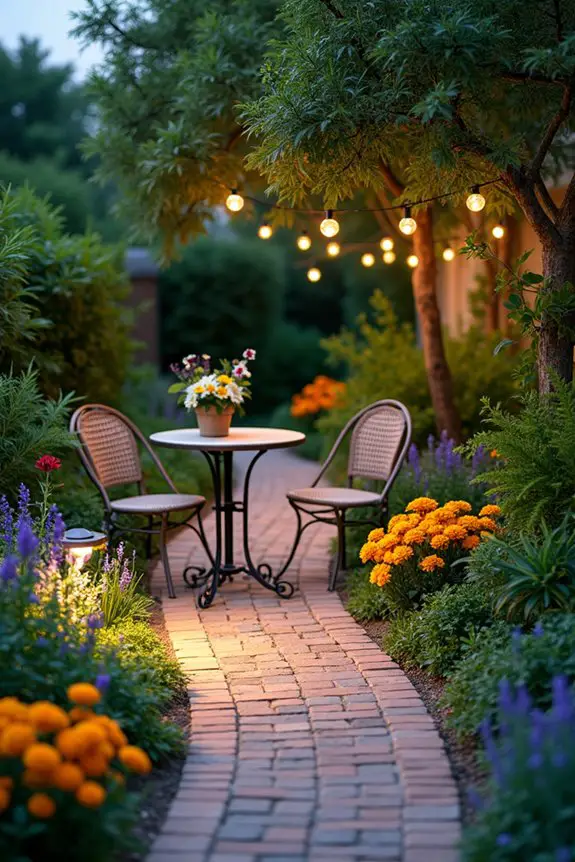
When it comes to creating pathways in your garden, the design you choose matters just as much as the plants themselves. A well-planned pathway not only leads you on a little adventure through your outdoor space but also enhances the overall vibe. Imagine strolling down a charming path, lined with your favorite flowers and herbs, feeling like you’ve stepped into your own private Eden. Talk about a mood booster.
First off, think about materials. Gravel, stepping stones, or even bricks can work wonders. I once tried using flat stones I found around my yard—sounds eco-friendly, right? But let me tell you, they turned out to be so uneven that I felt like I was on a surprise obstacle course every time I stepped outside.
Now, I go for smooth, level bricks, which keep my feet happy and my garden looking neat.
Next, consider the width of your pathway. You want it spacious enough to accommodate you carrying a basket of fresh herbs or perhaps your neighbor carrying that over-the-top dessert she brought over for the cookout. Aim for at least two feet wide—this allows for easy access and lets you strut your stuff without fear of a tumble.
I learned that the hard way when I tried to squeeze through a narrow gap while holding a tray of sandwiches. Just picture the grainy photo evidence.
And hey, don’t forget about the curves! Straight lines can feel a bit too formal for a garden, don’t you think? Gentle curves add a natural, whimsical touch, creating a flow that pulls your eye from one beautiful area to another.
I tried a straight path once, and it felt more like a runway than a stroll through nature. But when I switched to a meandering path, it was like my garden finally breathed a sigh of relief—so much more inviting.
Lastly, think about lighting along your pathway. Solar-powered lights can make your garden shine at night and also keep you from tripping over your own feet after dusk.
I once had candles along my path—it was romantic until the wind kept blowing them out, leaving me fumbling in the darkness. With solar lights, not only do I get a cozy glow, but I can stroll around without forming new dance moves to avoid stepping in puddles.
Designing pathways in your garden takes a little thoughtful planning, but the end result is worth every effort. You’ll create a space that feels open, inviting, and perfectly tailored to your gardening adventures.
Who wouldn’t want to explore their little oasis like a true garden explorer?
8. Modern Minimalist Garden Design
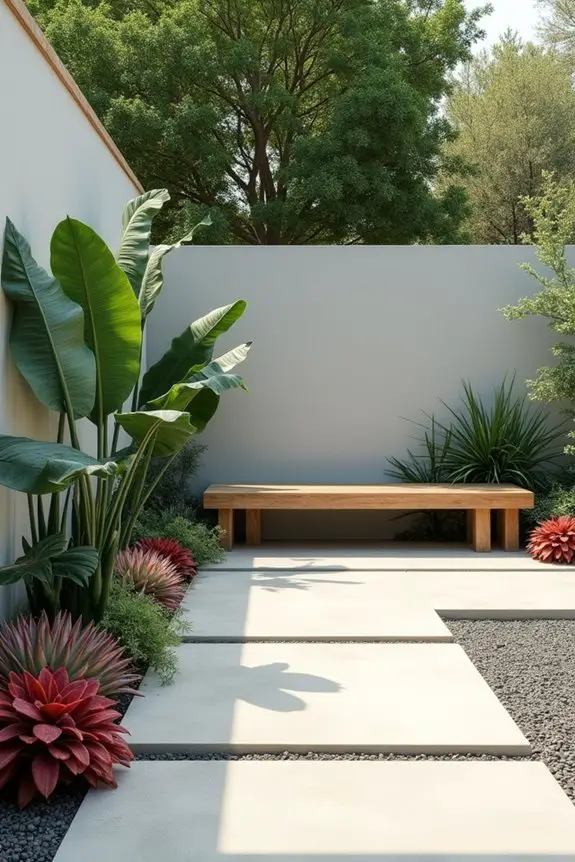
When you’re diving into modern minimalist garden design, you might think it’s all about clean lines and a lack of clutter. But there’s so much more to it! This style not only keeps things functional but also infuses a sense of calm and tranquility. Picture a tidy space where each plant, stone, and bench plays a purposeful role, creating a serene retreat that feels invigorating—like a deep breath on a stressful day.
Start by envisioning the layout. A minimalist garden doesn’t mean you toss your favorite flowerbed out the window; it’s about being clever with the space you use. Choose a few statement plants—think big, leafy monstera or a striking succulent arrangement. Tromping through my old garden with its floral chaos taught me the joy of simplicity. I swapped endless blooms for a few bold, elegant plants, and voilà! It’s like my garden weeded out its own drama.
Next, consider the hardscape. Use materials like smooth concrete or elegant stone to create clean lines. This not only provides balance but also serves as the backbone of your layout. I once thought my patio would look cool with mismatched patio tiles, and instead, it looked like a game of Tetris gone wrong.
So I opted for a sleek, uniform design that’s easy on the eyes and keeps the focus where it belongs—on nature.
Incorporate open spaces. The beauty of minimalism lies in its breathing room. Leaving areas unobstructed allows your eyes to wander and your mind to relax. I made the mistake of cramming too much into one corner, envisioning it as the “Garden Extravaganza.” It turned into the “Garden Chaos Festival.”
Now, I design with negative space in mind, making sure each inch has room to shine, like a well-edited book where every word feels essential.
Finally, don’t forget about the seating. A simple bench or a few well-placed stools can transform your garden into a cozy hideaway. Opt for designs with clean lines; nothing too fussy. I learned the hard way not to try and squeeze my overstuffed garden chairs into this style—sharp angles and simplicity were the way to go.
A sleek seat lets you sit back, relax, and enjoy the beauty around you without too much fuss.
9. Water Feature Design Concepts
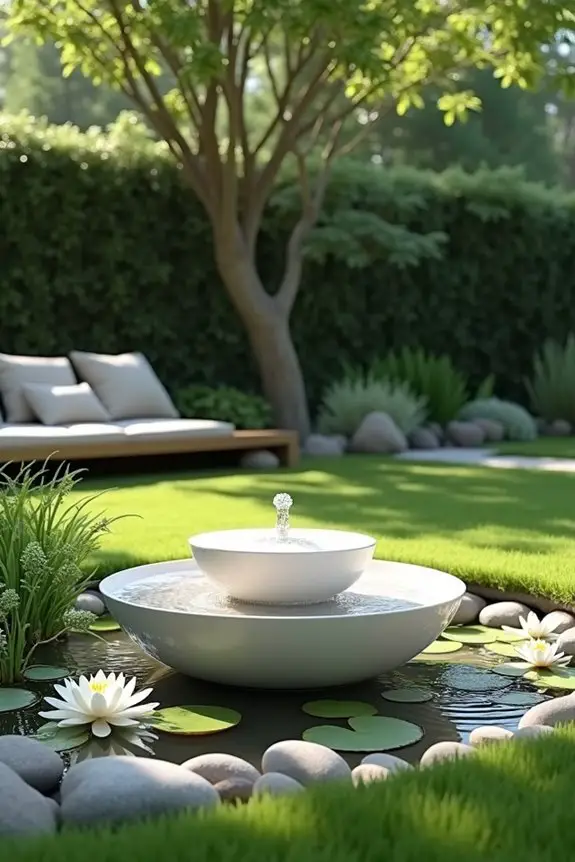
When it comes to adding a water feature to your minimalist garden, the possibilities can feel endless yet beautifully serene. Imagine the gentle sound of water trickling, providing a calming backdrop while serving as a striking focal point. It’s like having your own slice of nature’s symphony, where each droplet plays a note in the harmony of your outdoor space.
Start with a simple pond or a tiny fountain. You don’t need an Olympic-sized swimming pool to make an impact. Even a small bowl filled with water and a few floating lily pads can do wonders.
I once tried to create a grand waterfall in my yard—let’s just say my DIY project turned into a waterlogged disaster. A simple fountain, on the other hand, is way more manageable and provides that soothing sound we all love.
For layout, think about positioning your water feature so it’s visible from your seating area. Creating a stunning sight and sound will help you feel relaxed as you unwind with a good book or your favorite cup of tea.
I learned this the hard way after placing my fountain out of sight. I let it run, expecting zen, only to forget about it completely. Talk about a missed opportunity for tranquility!
Consider integrating some smooth stones or pebbles around your water feature. Not only do they enhance the aesthetic appeal, but they also emphasize the clean lines you’re aiming for in a minimalist garden.
I once tried to decorate with a wild assortment of rocks, and it ended up looking like a rocky beach had a meltdown in my backyard. Now, I stick with just a few carefully chosen stones that play nice with the water and plants around them.
Think about adding aquatic plants too. They won’t just look lovely; they’ll also help maintain the water quality. It’s like getting nature to do some of the heavy lifting for you.
Just last summer, I tossed a few water lilies into my tiny pond, and they brought it all to life—talk about instant lushness. Plus, they attract little critters like frogs and dragonflies, adding a lively vibe to the garden.
In short, adding a water feature is all about harmony. It creates a vibrant oasis, while also giving you a space to breathe, relax, and enjoy the beauty of simplicity.
10. Edible Landscape Design Concepts
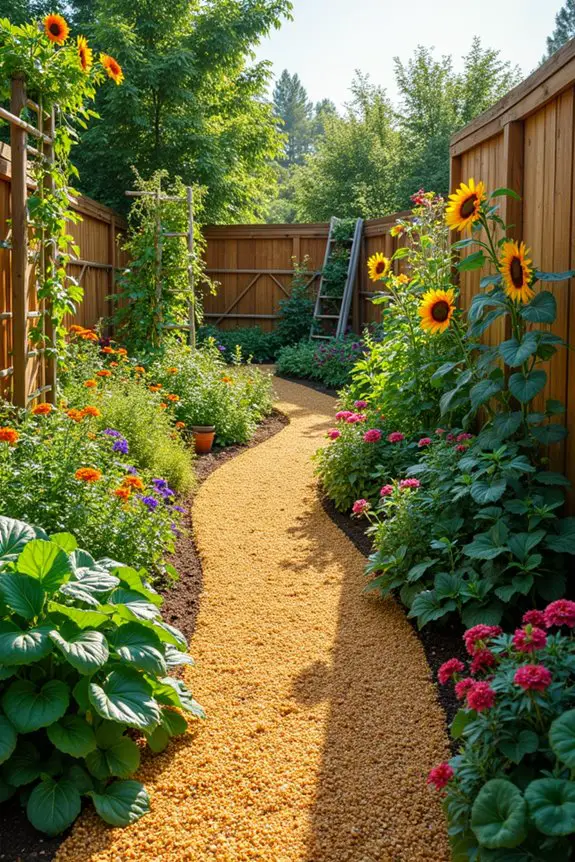
When it comes to edible landscape design, combining beauty and functionality is like having your cake and eating it too. Picture lush rows of vegetables and herbs that not only feed your family but also look stunning in your garden. It creates a vibe that’s both inviting and productive, turning your backyard into a feast for the eyes and the belly.
Start by thinking about your layout. Imagine curving garden beds snaking through your space, rather than rigid rows. This gives a softer, more organic feel.
I once went for a straight-line approach, and let’s just say my yard felt more like a marching band than a cozy retreat. Planning your garden in a way that draws the eye—maybe a gentle spiral or an eye-catching centerpiece of tall sunflowers—can really elevate the overall look.
For plants, mix in flowers with your fruits and veggies. The colors burst together, making everything pop. Think about planting nasturtiums next to your tomato plants—beautiful, edible, and they attract pollinators too.
Last summer, I tried to grow a wall of zucchinis, and while it did provide me with enough squash to feed a small army, I missed mixing in those vibrant florals that would’ve made my garden sing. Remember, beauty and function go hand in hand.
And don’t forget about vertical gardening! If space is limited, think about training your cucumbers or peas to climb a trellis. It’s like giving them a stage to perform on.
I used an old ladder for my beans last year, and while it looked rustic, I still felt a bit like a gardening magician as I harvested them from the heights. Plus, it opens up ground space for more plants—score!
Finally, don’t shy away from using paths or borders in your edible garden. Adding a bit of gravel or mulch not only organizes the area but helps keep your shoes clean during harvest time.
Trust me, I once plowed through my otherwise lovely garden in flip-flops, and the mud incident wasn’t pretty. A little organization goes a long way in keeping things tidy and charming.
In essence, creating an edible landscape is about harnessing nature’s bounty while adding a dash of beauty.
Maintenance Schedule Checklist
Staying on top of a garden’s needs can feel like a juggling act, especially if you’re trying to whip up a culinary masterpiece at the same time.
To make it easier, you’ll want a simple garden ideas checklist. Start by plotting your tasks weekly—water early, weed midweek, and prune before the weekend.
Don’t forget to check for pests; they’re the unwelcome guests at your garden party.
Monthly, refresh mulch and check the soil health; it’s like giving your plants a good meal.
Every season, refocus on your plan; maybe switch up your veggies. It’s all about keeping it manageable.
Sure, you’ll have moments when the weeds overwhelm, but with a schedule, you’ll feel like a garden rock star, not a total novice.

